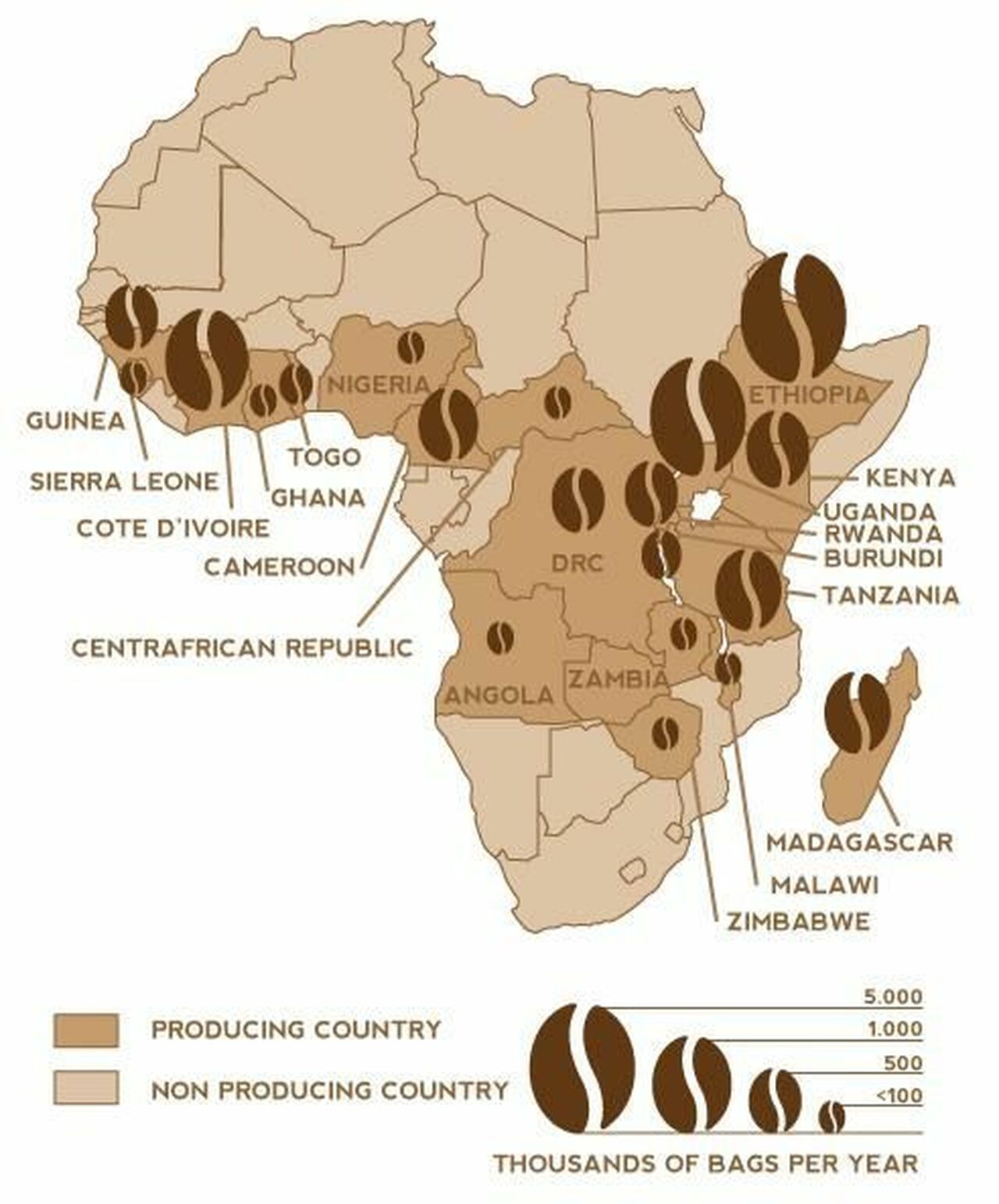African Coffee Regions Explained: From Ethiopia to Uganda

TL;DR:
Africa is the birthplace of coffee, and each region produces beans with distinct flavors, aromas, and characteristics. Dive into our: African Coffee Regions Explained. From Ethiopia’s floral Arabicas to Uganda’s robust Robustas, understanding the geography, climate, and cultivation methods helps coffee lovers, roasters, and traders appreciate Africa’s diverse coffee heritage.
Introduction: Africa, the Cradle of Coffee
Africa is synonymous with coffee excellence. Its fertile soils, high altitudes, and favorable climates have given the world some of its most celebrated coffee beans. African coffee is not just about flavor; it’s a cultural, economic, and historical phenomenon.
Coffee farming is concentrated in two primary species:
-
Arabica (Coffea arabica) – prized for flavor, mostly high-altitude regions
-
Robusta (Coffea canephora) – hardier, higher caffeine, low-altitude regions
Understanding the regional differences allows coffee enthusiasts to identify beans by origin, taste, and quality, while helping farmers and exporters market their products effectively.

Ethiopia: Birthplace of Arabica
-
Regions: Sidamo, Yirgacheffe, Harrar, Limu
-
Altitude: 1,500–2,200 meters
-
Flavor profile: Bright acidity, floral, citrus, berry notes
-
Highlights: Heirloom varietals, natural and washed processing methods
Ethiopia is considered the original home of Arabica coffee. Its beans are complex and aromatic, often used in specialty coffee markets worldwide. Farmers rely on traditional methods, such as sun drying on raised beds, to preserve delicate flavors.
Kenya: Bright and Vibrant Beans
-
Regions: Nyeri, Kirinyaga, Kiambu, Embu
-
Altitude: 1,500–2,100 meters
-
Flavor profile: Bold acidity, blackcurrant, citrus, wine-like notes
-
Highlights: “Kenya AA” designation denotes large bean size and premium quality
Kenyan Arabicas are famous for their vibrant, full-bodied flavor and are highly sought after in the specialty coffee industry. Farmers often use washed processing, enhancing the bright, fruity flavors.
Rwanda & Burundi: Volcanic Soil Gems
-
Regions: Northern Rwanda, Kayanza and Ngozi in Burundi
-
Altitude: 1,200–2,000 meters
-
Flavor profile: Sweet, mild chocolate, red fruit notes
-
Highlights: Volcanic soils, smallholder cooperative farms
Rwandan and Burundian Arabicas are smooth and balanced, making them ideal for filter coffee and espresso blends. These countries focus on quality-focused cooperatives to enhance export potential.
Uganda: The Land of Robusta
-
Regions: Central and Western Uganda
-
Altitude: 700–1,200 meters
-
Flavor profile: Earthy, chocolatey, nutty
-
Highlights: Largest Robusta producer in Africa
Ugandan Robusta beans are resilient and high-yielding, forming a backbone for instant coffee and espresso blends globally. Arabica is also grown in the highlands, but Robusta dominates lowland areas.
Ivory Coast & Cameroon: Robust African Robusta
-
Regions: Southern Ivory Coast, Western Cameroon
-
Altitude: Lowland plantations, 200–800 meters
-
Flavor profile: Bitter, nutty, full-bodied
-
Highlights: Economically vital, supports local markets and exports
These countries specialize in Robusta coffee due to its hardiness and consistent yields, which ensures economic stability for local farmers.
Key Factors Affecting African Coffee Regions
-
Altitude: Higher altitudes favor Arabica; lower altitudes favor Robusta.
-
Soil Type: Volcanic soils provide minerals that enhance bean complexity.
-
Climate: Rainfall, temperature fluctuations, and sunlight affect flavor and yield.
-
Processing Methods: Washed vs. natural (dry) processing impacts taste profiles.
-
Smallholder Practices: Cooperative farming boosts quality, sustainability, and fair trade opportunities.
☕ Brewing Tips by Region
| Region | Recommended Brew | Notes |
|---|---|---|
| Ethiopia | Pour-over, Chemex | Highlight floral, citrusy notes |
| Kenya | AeroPress, French press | Bright acidity, blackcurrant flavors |
| Rwanda/Burundi | Filter coffee, Espresso | Smooth, chocolatey undertones |
| Uganda | Espresso, French press | Earthy, nutty, high caffeine |
| Ivory Coast/Cameroon | Espresso, Instant coffee | Bitter, robust body |
Why Regional Knowledge Matters
-
Flavor Profiling: Identify beans by origin for desired taste.
-
Roaster Strategy: Tailor roast profiles based on bean characteristics.
-
Economic Insight: Support ethical sourcing and fair trade practices.
-
Marketing Advantage: Highlight origin stories in cafes and retail markets.
The African Coffee Legacy
African coffee regions reflect a rich tapestry of culture, geography, and agriculture. From Ethiopia’s highlands to Uganda’s lowlands, each region contributes unique flavors, economic value, and heritage. By understanding regional differences, coffee enthusiasts and industry professionals can make informed choices, support sustainable farming, and celebrate Africa’s coffee diversity.
❓ FAQs
1. Which African country produces the best Arabica coffee?
Ethiopia is renowned for its heirloom Arabica beans with complex floral and fruity notes.
2. Which African country produces the most Robusta coffee?
Uganda leads in Robusta production, providing a high-yield, caffeine-rich bean.
3. Are all African coffees single-origin?
Not always. Some regions blend beans for flavor balance, but many premium coffees highlight single-origin characteristics.
4. How does altitude affect coffee flavor?
Higher altitudes slow bean maturation, creating complex, aromatic flavors, often associated with Arabica. Lower altitudes favor Robusta’s resilience and body.
5. What is the difference between washed and natural coffee processing?
-
Washed: Beans fermented and washed, highlighting clarity and acidity.
-
Natural (dry): Beans dried with fruit pulp intact, producing fruity, wine-like flavors.